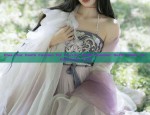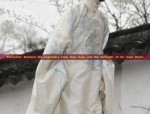The Cultural Interest of Cheongsam in the Republic of China
In the Republic of China era, the cheongsam, a traditional Chinese dress, experienced a renaissance as it merged with modern fashion trends and became a symbol of cultural and artistic expression. The cheongsam, which had been worn by women in China for centuries, underwent changes in design and style that reflected the evolving tastes and interests of the people during this period.

The cheongsam's history in the Republic of China is deeply intertwined with the cultural and social transformations of the era. As China began to embrace modernization, the cheongsam became a medium for expressing personal freedom and individuality. Women's fashion in this period was no longer confined to traditional attire but began to evolve with changing social norms and western influences.
The cheongsam's design and style during the Republic of China era were influenced by various factors such as western fashion trends, traditional aesthetics, and the evolving tastes of the masses. The design featured a slim fit that accentuated the female figure, with intricate details such as patterns and embellishments that added a touch of elegance and beauty. The cheongsam became a symbol of feminine grace and beauty, which was further amplified by the cultural and artistic movements of the time.
The cheongsam's popularity during this era was further fueled by cultural events and festivals. As a traditional dress, it was often worn during festivals and celebrations, providing an opportunity for people to display their cultural heritage and artistic talent. The cheongsam also became a medium for expressing political and social views, as women wore it as a symbol of their rights and freedoms.
Moreover, the cheongsam's popularity was not limited to the upper classes but spread to the masses as well. As fashion trends became more democratic and accessible to all, the cheongsam became a popular choice for women across different social classes. It was not just a dress but a symbol of cultural identity and pride.
The cheongsam's influence during this period extended beyond fashion to other aspects of culture such as music, dance, and art. It became a symbol of Chinese culture and art that was widely recognized and appreciated worldwide. The cheongsam's elegance and beauty inspired many artists to create works of art that featured this traditional dress, further enhancing its popularity and influence.
The cheongsam's legacy in the Republic of China era is significant and continues to influence fashion and culture even today. Its design elements and style continue to inspire designers and fashion enthusiasts who seek to revive traditional fashion trends. The cheongsam's influence has also spread to other parts of the world, where it is appreciated for its elegance, beauty, and cultural significance.
In conclusion, the cheongsam in the Republic of China era was not just a dress but a symbol of cultural heritage, artistic expression, and personal freedom. Its influence extended beyond fashion to other aspects of culture, leaving a lasting impact on society and shaping the way people perceive Chinese culture and art. Its legacy continues to inspire designers and fashion enthusiasts even today, highlighting its enduring value and importance in Chinese culture.
Moreover, the cheongsam's journey from traditional attire to a symbol of modern cultural expression is a testament to the resilience and adaptability of Chinese culture. The cheongsam's evolution reflects the changing times and social norms, demonstrating how traditional elements can be combined with modern designs to create something new and relevant even in modern times. The cheongsam continues to inspire people worldwide with its beauty, elegance, and cultural significance, highlighting its enduring value in Chinese culture.

 Previous Post
Previous Post







